The GYAO mini-game in Dave the Diver, while immensely enjoyable, initially presents a learning curve due to the lack of an in-depth official tutorial explaining its mechanics and nuances. This comprehensive guide is tailored to fill that gap, offering players a thorough understanding of how the GYAO mini-game operates.
How to Unlock GYAO?
To access the GYAO! mini-game in Dave the Diver, players are required to finish the “Stormy Night” side quest, given by Sato. This quest, which is encountered later in the game, involves diving into a whirlpool to confront and defeat the Mantis Shrimp boss. Successfully overcoming this challenge completes the side quest, subsequently unlocking the traditional Tamagotchi-style GYAO! mini-game.
How to Care for GYAO?
After you unlucked the GYAO minigame open your phone and navigate to the Minigames app.
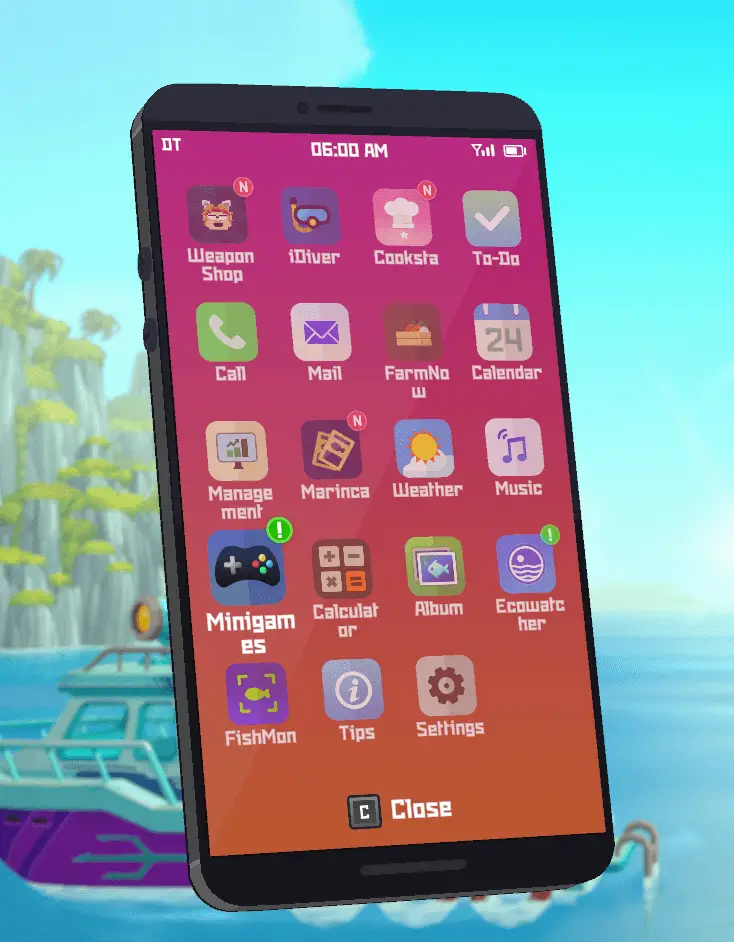
In this app you can see all your unlocked minigame apps select GYAO “Raise GYAO, a digital fish!”
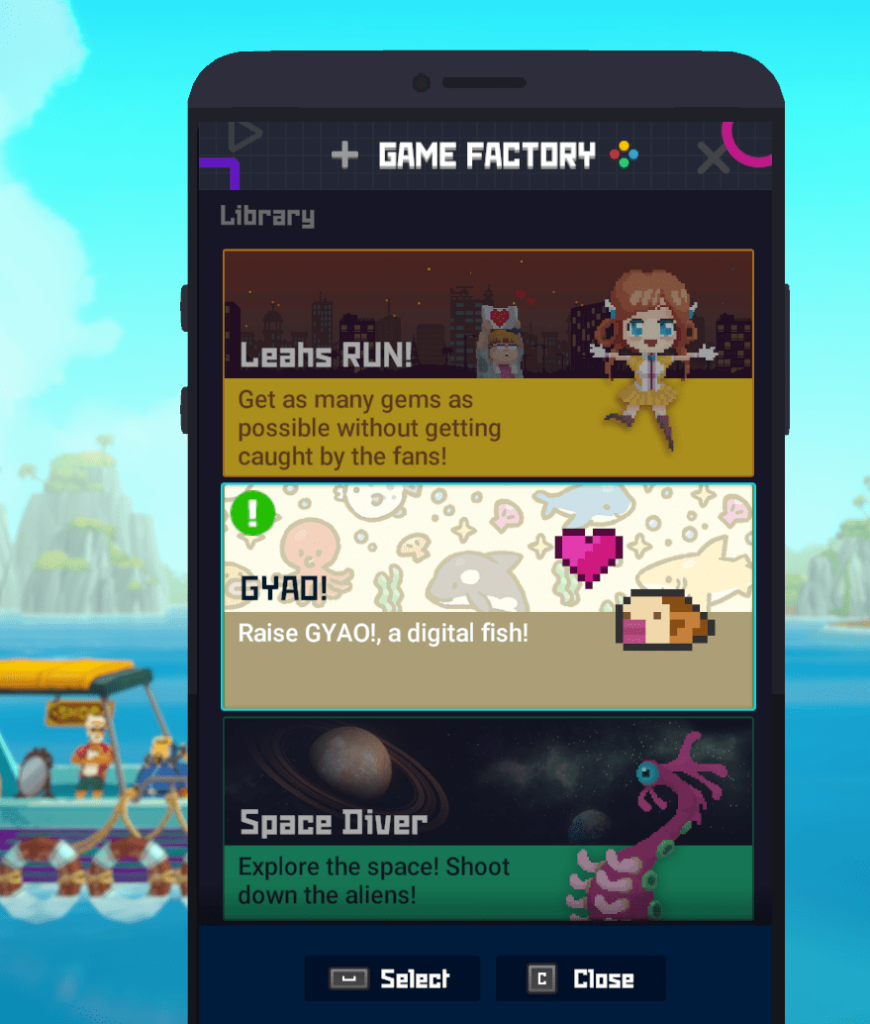
Within the mini-game, players will notice multiple tabs positioned both above and below the area where the fish is displayed. These tabs serve to offer guidance and instructions, helping navigate through various aspects of the game.
GYAO Meal
Located in the top left corner is the shrimp icon; selecting and opening this menu allows you to choose between two options: food and snacks. Each of these options fulfills distinct purposes in the care and management of Gyao.
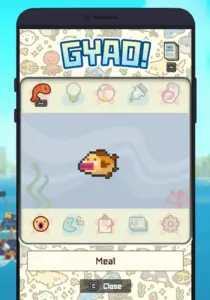
GYAO Food
The “Food” section on the management screen tracks Gyao’s hunger status. As you feed your fish, the quantity of food servings you’ve provided will be shown, allowing you to monitor and manage Gyao’s nutritional needs efficiently.
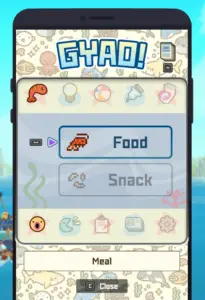
Should you overfeed, Gyao will exhibit reluctance towards consuming more food, indicating a refusal to eat beyond its capacity.
GYAO Snacks
Within the meals section, there’s an option to treat Gyao to snacks. Unlike regular meals, snacks do not contribute to Gyao’s hunger levels.
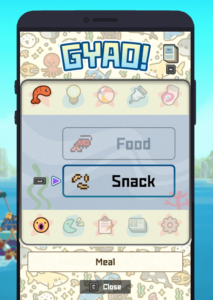
Their primary purpose is to marginally boost affection, providing an alternative method to enhance hearts/affection besides engaging in the shell mini-game found under the Play tab.

Feeding candy to Gyao serves as a means to increase its fondness for you, enhancing the affection level between Gyao and its caretaker.
GYAO Play
When you select the top middle menu item “the beach ball” you can play with GYAO. Engaging in playtime with Gyao is a way to enhance its affection level.
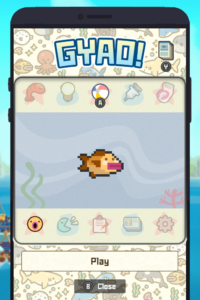
There is a mini-game available where three conch shells shuffle around, and your task is to track and identify which shell conceals a pearl beneath it.
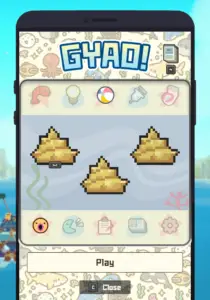
The second mini-game involves making a choice between left or right, with the objective being to select the same direction as Gyao.
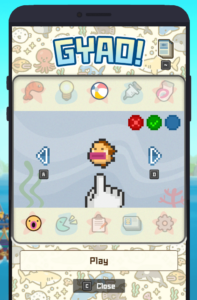
Successfully aligning your choice with Gyao’s direction results in a win for the round of play.
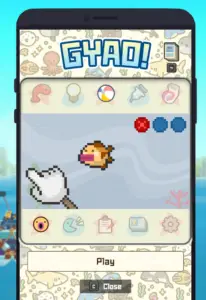
GYAO Clean
If you notice that your fish’s environment is soiled with excrement along the sides, you should press the clean button to tidy up the habitat.
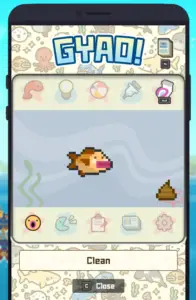
To do this click on the toilet on the upper right corner.

GYAO Heal
Located on the right side of the screen, a purple skull icon that becomes visible when Gyao requires medical care. Should this icon appear, it’s imperative to press the medicine button to administer treatment and ensure Gyao’s health is restored. This action is crucial for maintaining the well-being of your virtual pet.
GYAO Lightning
Managing Gyao’s sleep cycle is an essential aspect of its care, particularly during nighttime hours. To guarantee a restful sleep for Gyao, it is advisable to turn off the lights in its environment in the evening, prior to operating the restaurant. This action simulates a natural sleeping environment, contributing to Gyao’s overall health and well-being. At the top left you can find the light bulp that opens the lighting menu here you can turn on or off the lights.
GYAO Warning
The “Warning” indicator functions not as an interactive button but as an alert system that illuminates whenever Gyao encounters a problem. Should any care elements, such as feeding, cleaning, or health management, be neglected, this feature activates to signal that Gyao is experiencing an “issue.” This alert serves as a helpful reminder to address any needs that may have been overlooked, ensuring Gyao’s well-being is maintained. If you see “ZZZ” this means sleep or the pink skull that your GYAO needs medicine.
GYAO Disipline
When you observe your fish exhibiting odd sounds or movements, yet it does not require food, cleaning, and appears content, the appropriate action is to access the discipline tab. Engaging this function enhances its training level and deactivates the warning light, indicating an issue has been resolved. However, it’s important to note that the discipline level might diminish the following day. Consequently, maintaining a high training standard for your fish necessitates regular discipline to ensure consistent behavior and well-being. You can find this option in the bottom left shouting emoji icon.
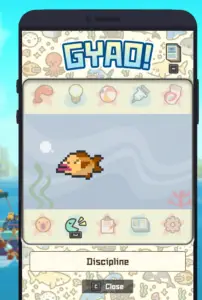
GYAO Options
Adjusting the notification settings on your phone allows you to toggle them on or off, providing flexibility in receiving alerts from the mini-game. By doing so, you can create periods of interruption-free time when you prefer not to engage with the game, offering a convenient way to manage your availability and gameplay experience. In the bottom right corner you can find the gear icon to open te menu.
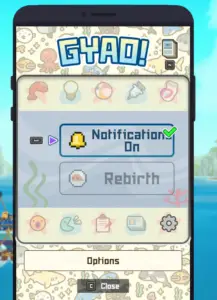
GYAO Memories
In the memories tab you can find your previous raised GYAOS. You can favorite up to 50 raised GYAOS. This screen also displays the final age and the weight when the GYAO died.
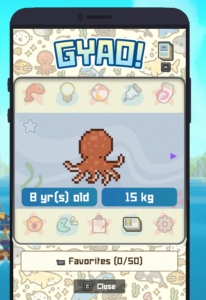
GYAO Manage
The manage tab serves as a comprehensive dashboard for monitoring the status and progress of the current GYAO under your care. Within this section, you can view vital statistics including the GYAO’s current age and weight, alongside a detailed assessment of its hunger level (ranging from 0 to 4), affection level (also from 0 to 4), and training status. This information is crucial for making informed decisions about how to best care for and interact with your GYAO, ensuring its well-being and happiness.
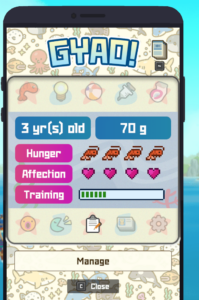
GYAO Revive
Following the demise of a GYAO!, players are presented with an option to “revive” their Gyao. However, the term “revive” might be somewhat misleading, as it doesn’t bring back the deceased Gyao. Instead, selecting this option provides players with a new egg, allowing them to begin anew with a different Gyao. Consequently, the cycle of life for Gyaos in the game dictates that the passing of a current fish is a prerequisite for the opportunity to nurture another.
GYAO Collection
To open the collection screen you need to select the icon on the top right corner right above the toilet in the main menu of GYAO. The collection shows all the fish you have raised currently with information about the fish.
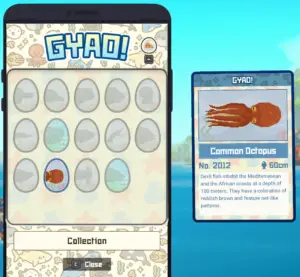
GYAO REWARDS
In the game, the sole function related to GYAO! culminates in the “GYAO! Master” achievement, which is awarded to players who successfully raise five Gyaos(They don’t need to be different types they can be the same). Additionally, as a bonus for nurturing your first Gyao, players are rewarded with an in-game boat skin.
How to Raise your GYAO?
To raise different types of GYAO! in the game, it’s crucial to employ varying strategies across three main care aspects: Food, Affection, and Discipline. Each of these factors influences the growth and evolution of your GYAO!, with the game simulating a GYAO’s lifespan where 1 day equates to 1 year of growth.
The GYAO! progresses through a defined life cycle, starting from roe, evolving into a fry, then maturing into a small fish. At this juncture, based on the level of affection it has received, it can evolve into one of two distinct forms:
- A Docile yellow fish, which occurs if the GYAO! receives high levels of affection (an affection/intimacy level of 3 to 4) as a small fish.
- A Ferocious blue fish, which results from a lack of affection.
The evolutionary path culminates in a final stage, which is influenced by the care provided during the earlier stages of its life.
This evolutionary mechanic explains why the first GYAO! raised by players often turns into a beluga whale or a dolphin. A beluga whale signifies maximum affection and training, reflecting comprehensive care and discipline, whereas a dolphin represents a scenario where the GYAO! receives plenty of affection but perhaps not enough training. This system encourages players to engage deeply with the care mechanics to explore the various evolutionary outcomes of their GYAO!
The game features 14 distinct GYAO variants, which can broadly be categorized into two groups based on their temperament: docile and ferocious. Among these variants, two specific evolutionary paths exist for already mature GYAOS, leading to the development of rare fish types under certain conditions:
- A Beluga evolves into a Whale Shark.
- A Lemon Shark evolves into an Orca.

The pivotal requirement for these evolutions is a fully maxed training bar. However, there are specific age constraints to be mindful of for these transformations to occur:
- Beluga whales must achieve full training before reaching the age of 9 years. Failing to meet this training criterion by the age threshold results in the beluga’s demise.
- Lemon sharks, on the other hand, must be fully trained by the age of 12 years. Similar to belugas, failure to fully train a lemon shark by this age results in its death.
These conditions highlight the importance of timely and focused training to unlock these rare and powerful evolutionary outcomes, adding a layer of strategic depth to the care and management of GYAO within the game.
Stats and mechanics
In managing your GYAO’s needs, the game employs a system that quantifies the effects of your actions on its wellbeing, categorized into satiation, intimacy, and training. Here’s how each action impacts your GYAO:
- Feeding: Each feeding session increases satiation by +1.
- Giving Snacks: Offering snacks boosts intimacy by +1.
- Playing: Engaging in playtime with your GYAO enhances intimacy by +2.
- Discipline: Each discipline session contributes +3 blocks to the training level.
The game also simulates the passage of time and its effects on your GYAO’s needs:
- Time Progression: As the game transitions from one time phase to another (morning to afternoon, afternoon to evening, or evening to the next morning), your GYAO loses 1 point each in food and intimacy. This mechanic simulates the natural decline in satiation and emotional connection over time, necessitating regular care.
- Improper Medical Care: Administering an injection to your GYAO when it isn’t sick will lead to a decrease in intimacy by 1 point, reflecting the negative impact of unnecessary medical interventions.
- Training Loss: If the warning indicator remains active (or shows a green notification on the phone app) at night, indicating unresolved needs despite all possible care being provided, some amount of training will be lost by the morning. This simulates the effects of stress or discomfort on your GYAO’s learning and behavior.
Raising a Yellow ‘Docile’ Fish Possibilities
| Yellow Fish | 0 Love | 1 Love | 2 Love | 3 Love | 4 Love |
| 0 Food | Stubby Squid Trumpetfish | Stubby Squid Trumpetfish | Stubby Squid Trumpetfish | Dolphin Beluga | Dolphin Beluga |
| 1 Food | Stubby Squid Trumpetfish | Stubby Squid Trumpetfish | Stubby Squid Trumpetfish | Dolphin Beluga | Dolphin Beluga |
| 2 Food | Stubby Squid Trumpetfish | Green Sea Turtle Manatee | Green Sea Turtle Manatee | Dolphin Beluga | Dolphin Beluga |
| 3 Food | Stubby Squid Trumpetfish | Stubby Squid Trumpetfish | Stubby Squid Trumpetfish | Dolphin Beluga | Dolphin Beluga |
| 4 Food | Stubby Squid Trumpetfish | Stubby Squid Trumpetfish | Stubby Squid Trumpetfish | Dolphin Beluga | Dolphin Beluga |
Highlighted box means discipline can affect which ones you get. The threshold is 9 bars. If you have less than 9 bars of discipline, your fish will evolve into the top one. If you have less than 9 bars of discipline, your fish will evolve into the top one. If you have 9 bars or more discipline, your fish will evolve into the bottom one
Raising a Blue ‘Fierce’ Fish Possibilities
| Yellow Fish | 0 Love | 1 Love | 2 Love | 3 Love | 4 Love |
| 0 Food | Yellowfin Puffer Red Octopus | Yellowfin Puffer Red Octopus | Yellowfin Puffer Red Octopus | Yellowfin Puffer Red octopus Lemon Shark | Yellowfin Puffer Red octopus Lemon Shark |
| 1 Food | Yellowfin Puffer Red Octopus | Yellowfin Puffer Red Octopus | Yellowfin Puffer Red Octopus | Parrotfish Lemon Shark | Parrotfish Lemon Shark |
| 2 Food | Yellowfin Puffer Red Octopus | Hammerhead Ribbon Eel | Hammerhead Ribbon Eel | Yellowfin Puffer Red octopus Lemon Shark | Yellowfin Puffer Red octopus Lemon Shark |
| 3 Food | Yellowfin Puffer Red Octopus | Yellowfin Puffer Red Octopus | Yellowfin Puffer Red Octopus | Yellowfin Puffer Red octopus Lemon Shark | Yellowfin Puffer Red octopus Lemon Shark |
| 4 Food | Yellowfin Puffer Red Octopus | Yellowfin Puffer Red Octopus | Yellowfin Puffer Red Octopus | Yellowfin Puffer Red octopus Lemon Shark | Yellowfin Puffer Red octopus Lemon Shark |
Raising a Whale Shark or an Orca
Achieving the evolution of a beluga into a whale shark or a lemon shark into an orca requires meticulous planning and strategic management due to the complexities of the training system. Here are the specific conditions and a strategy to navigate these challenges:
- Whale Shark Evolution: A beluga must reach full training by the age of 9 to evolve into a whale shark.
- Orca Evolution: A lemon shark needs a full training bar by the age of 12 to evolve into an orca.
Given that training levels can decrease after each night’s sleep, maintaining the required training level up to the point of evolution presents a significant challenge. This is where strategic timing comes into play:
- Timing Revival: By reviving your Gyao in the afternoon, you align its evolution cycle with the game’s night-time phase. This alignment ensures that any potential decrease in training that occurs after sleeping happens right before the critical evolution point, giving you two additional periods (morning and afternoon) to recover or boost the training stats.
- Maximizing Opportunities: This approach offers two distinct opportunities to address any unexpected drop in training levels. Since training can be the most volatile factor affecting evolution, having the morning and afternoon to rectify any decreases significantly enhances your chances of meeting the evolution criteria.
This strategy not only optimizes the management of training levels but also mitigates the risk of failing to meet the necessary conditions for evolution due to the natural decrement in training levels after sleeping. It’s a proactive approach to ensure that you have adequate time to adjust and secure the desired evolutionary outcome for your Gyao.
Important notes
Navigating the lifecycle of a GYAO involves understanding both the nurturing and the concluding phases of its life. Here are key points to consider for those aiming to explore the full breadth of the GYAO experience:
- Lifecycle and Death: GYAOS are subject to a natural lifecycle with a general span of about 10 in-game days (equivalent to years), after which they will pass away from old age, regardless of the level of care provided. Additionally, neglecting a GYAO by not addressing its needs for food, cleanliness, and health can hasten its demise due to fasting, sickness, or unclean conditions.
- Raising Another GYAO: The game’s mechanics necessitate the death of your current GYAO to start anew with another. If your goal is to raise a different GYAO, you may choose to expedite the dying process by abstaining from feeding, cleaning, or healing your current GYAO.
- Reviving a GYAO: Upon the death of a GYAO, you have the option to ‘revive’ it, which essentially starts the lifecycle over with a new egg. This mechanism allows players to experience raising various types of GYAOS and exploring different evolutionary paths.
- Gameplay Mechanics:
- Pressing the ESC key during an action can cancel the animation, saving time and streamlining the gameplay.
- Discipline or training actions are only available when the green exclamation mark is visible, indicating a need for attention in these areas.
- Achieving a fully evolved GYAO typically takes about an in-game week, emphasizing the game’s commitment to simulating a growth and development process.
- Achievements: For the “GYAO Master” achievement, the requirement is not to raise five distinct GYAOS but rather to successfully raise fully evolved GYAOS five times. This distinction allows players to focus on the evolution process rather than the variety of GYAOS raised.
- Utilizing Time Skip: Players should not hesitate to use the time skip feature to expedite the game’s processes. This mechanic can significantly reduce the real-time waiting periods associated with GYAO growth, evolution, and the overall game progression.
Another unexplained game mechanic is the auto supply option on the restaurant menu check it out here.


Leave a Reply